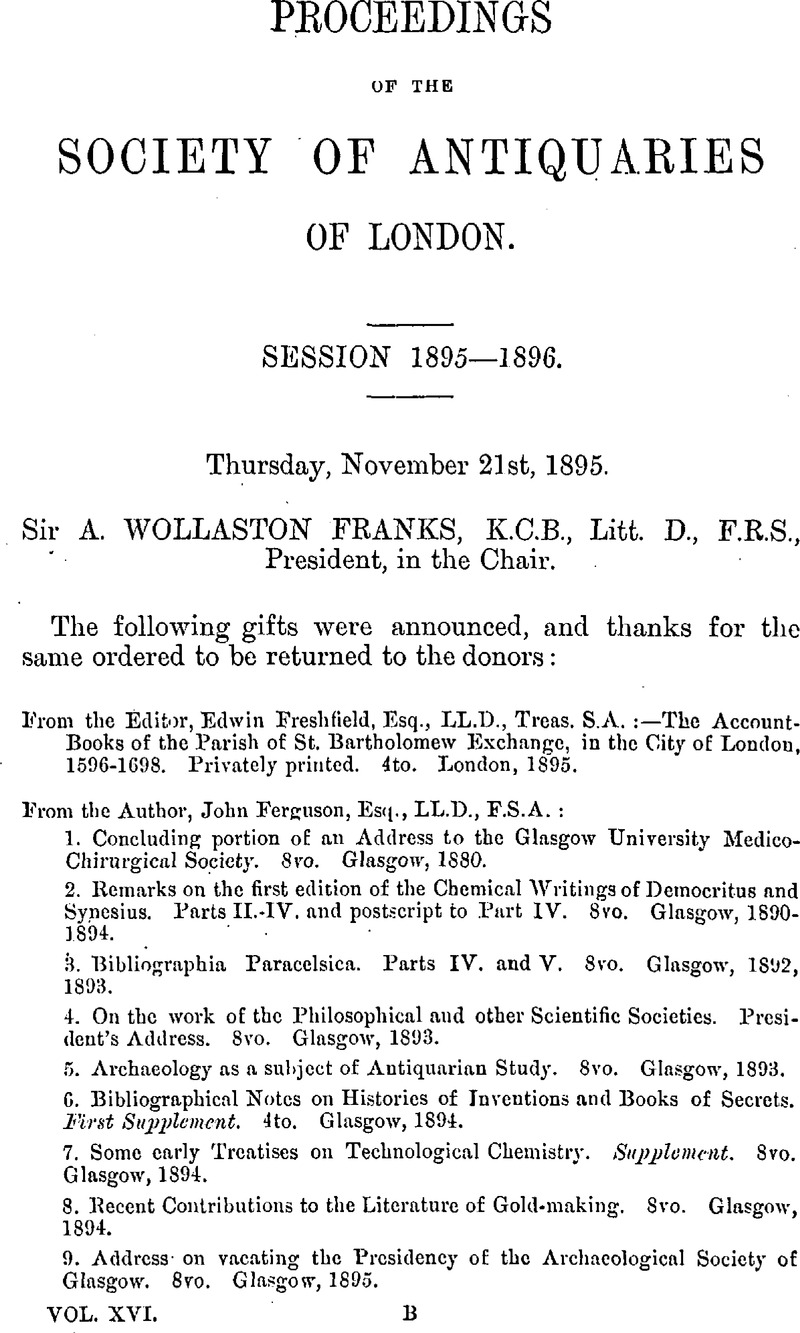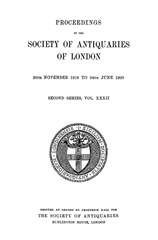No CrossRef data available.
Article contents
Thursday, November 21st, 1895
Published online by Cambridge University Press: 10 May 2010
Abstract

- Type
- Proceedings
- Information
- Copyright
- Copyright © The Society of Antiquaries of London 1897
References
page 6 note * Kemble, HoræFerales, pl. xviii. 2.
page 6 note † Op. cit. pl. xviii. 5.
page 6 note ‡ Op. cit. pl. xviii. 3.
page 7 note * This sword has since been acquired by the British Museum.
page 8 note * Mr. J. E. Payne informs me that he can find no earlier use of the name Wye for this river than the present century ; and that Wycombe is not from the Celtic word for water, but from the early Anglo-Saxon word (Widu) meaning forest.
page 9 note * This was the depth over the greater part of our excavation ; it varied, however, from 5 feet 6 inches from the present surface at the north, to 6 feet 1 inch at the south, but against this must be set a slight unevenness in the surface.
page 11 note * i.e. upwards of 6 feet space divided the western from the eastern group, if groups they can be called.
page 16 note * Leet Book, ff. 276a, 380a, 381, 329, 329a, 124a. Besides the account of the proceedings of the Court Leet, this volume contains numerous references to contemporary events.
page 16 note † Harl. MS. 6466, ff. 5, 6.
page 16 note ‡ The former are in possession of the corporation ; the latter in possession of the company.
page 16 note § Rogers, Six Centuries, i. 116.
page 16 note ‖ Rot. Parl. iii. 437.
page 16 note ¶ Litcræ Cantuarienses (Rolls Series, 85). iii. 81.
page 16 note ** Leet Book, f. 322a (1518).
page 17 note * On this subject v. Mrs. J. R. Green, Town Life, ii. 90.
page 17 note † In 1415. Rot. Parl. iv. 75.
page 17 note ‡ John Hales in the Commonweal of the Realm (cd. Lamond), p. 128. In the cloth trade the story is a similar one. In 1485 and 1495 the aulnago of Coventry and district was £23 ; that of Worcester and Hereford £13. In 1552 Worcester was a more important centre than Coventry. Ib. 77, note.
page 17 note § Ashley, Econ. Hist. ii. 95. A new fashion under Elizabeth of wearing “hats felts ” seriously affected the makers of woollen caps.
page 17 note ‖ Leet Book, f. 166.
page 17 note ¶ Ibid. f. 322. See Appendix, post, p. 29.
page 18 note * Rot. Parl. v. 569. There is a petition concerning the hindrance of the navigation of the river Severn ; Coventry, among other towns, is spoken of as being injured thereby.
page 18 note † The mercers' and drapers' apprentices were compelled to pay the admission fines on the sealing of their indentures, whereas in other fraternities these were not demanded until the period of apprenticeship was past. Leet Book. f. 322.
page 18 note ‡ Warne. Antig. Mag. pt. vi. 110.
page 18 note § Declaration 12 Edw. IV., Corporation MSS.
page 18 note ‖ Leet Book, f. 323.
page 18 note ¶ Ibid. f. 314.
page 19 note * Rot. Parl. iv. 75.
page 19 note † The terms “degree of a mayor—of a bailiff” were used in assessing fines. In the year 1449 a list of the craftsfolk of the city enables us to find out to what calling the members of the corporation belonged. (Leet Book, ff. 144–9).) On January 25, 1447, the twenty-four (the mayor's council) met to elect the officials for the ensuing year. The occupations of four of these men I cannot identify. Three were craftsmen, i.e. two dyers and a whittawer, and the remaining seventeen were either drapers or mercers who had previously filled either the mayor's post or the bailiff's. (Leet Book, f. 132.)
page 20 note * Gross, i. 123 and ii. 51. ITarl. MSS. 6466, ff. 5 and 6, cited by Grcss, ii. 51. The matter is capable of refutation in detail. This “general fellowship” consisted exclusively of pinners, tilers, and coopers. John Goodknabuff, or Godeknave, the master of the fellowship, was a cooper, and is mentioned in the Leet Book as belonging to that calling. He was a man of no standing whatever, and was never, as far as I know, employed in any municipal office, nor were any of his brethren whose names are given in the Wanley MS. John Swift, one of Godeknave's “fellows,” presumably one of the three keepers of the three united crafts, Godeknave having the precedence, may have been a son of William Swift, mentioned among the twelve pinners and tilers in a list composed in 1449. (Leet Book, f. 147a.)
page 20 note † Cf. the fellowship of the cardmakers, saddlers, masons, and painters. Of this fraternity it was said (1444) “they be long tyme ypast, have byn as oone fellauship in berying Costys, charges, and all other dueties of old tyme to ther pagent.” (Leet Book, f. 109.)
page 20 note ‡ Ibid. f. 215a.
page 21 note * Leet Book, f. 4a. The mayor, recorder, and bailiff were to take eight or twelve of the general council of the city, and to summon before them the wardens of the crafts with their ordinances, and these “poynts that byn lawful, good and honest for the cite be alowyd them and all other throwasid [sie], and had for none.” And this order was in substance repeated many times.
page 21 note † Leet Book, f. 148a.
page 21 note ‡ This rule was embodied in the fullers' rules. See Book of the Fullers (in possession of the Fullers' Company at Coventry), f. 6.
page 21 note § Leet Book, f. 351.
page 21 note ‖ In 1530. Leet Book, ff. 346, 351.
page 22 note * Leet Book, f. 322. A part of the proceeds of the craft fines frequently went to the repair of the town wall in the early fifteenth century. Among the cappers, fines for breach of regulations went “half to the mayor and half to the craft.” Ib. f. 276.
page 22 note † 17 H. VI. (Corporation MSS.) is a license to Mortmain, by which four messuages and a mill and a plot of ground 28 feet by 52 feet, on which the chapel of St. George stood at the Gosford Gate, were made over to the guild. This land was held by the tailors at the time of the Dissolution.
page 22 note ‡ Leet Book, f. 369a.
page 22 note § The corporation proposed in a petition to Parliament that the twenty-four who elected the mayor should choose two drapers and two dyers to overlook the craft, and “present” them for any “fault or confederacy.”
page 23 note * Leet Book, ff. 273, 273a.
page 22 note † English Historical Review, ix. 33–52.
page 22 note ‡ Mrs. J. U. Green, Town Life, ii. 100.
page 24 note * Leet Book, f. 27.
page 24 note † Ib. f. 276.
page 24 note ‡ Ib. In a later version of the rule (Ib. f. 329) this matter is worked out in detail. Each apprentice put in surety in £5 to remain with his master for the seven years. If the lad broke his covenant, it was only by handing over the £5 to the craft that the master could take an apprentice in his place.
page 24 note § Ib. f. 338.
page 24 note ‖ Ib. ff. 393a, 395a.
page 24 note ¶ Ib. f. 408a.
page 24 note ** Ib. f. 342.
page 25 note * Leet Book, f. 27.
page 25 note † The member was “to warn ” the master, who was to warn the other members of the fellowship (Carpenters' Accounts).
page 25 note ‡ Under penalty of (6s. 8d. (Carpenters' Accounts).
page 25 note § Leet Book, f. 273a. This order was re-euacted the next year (1405). Ib. f. 89.
page 25 note ‖ Ib. f. 89.
page 26 note * Corp. MSS. 8 H. IV. (IS November).
page 26 note † Ibid. 1 H. V. (8 March).
page 26 note ‡ Kiley, Memorials, 543.
page 26 note § Leet Book, f 27.
page 27 note * Carpenters' Accounts
page 27 note † Leet Book, f. 276.
page 29 note * This is rather obscure.
page 29 note † i.e. the Trinity Guild. This fraternity possessed a great amount of property in Coventry.
page 30 note * The elephant, i.e. the city seal, which bears the device of an elephant and castle.
page 29 note † Leet Book, f. 323.


